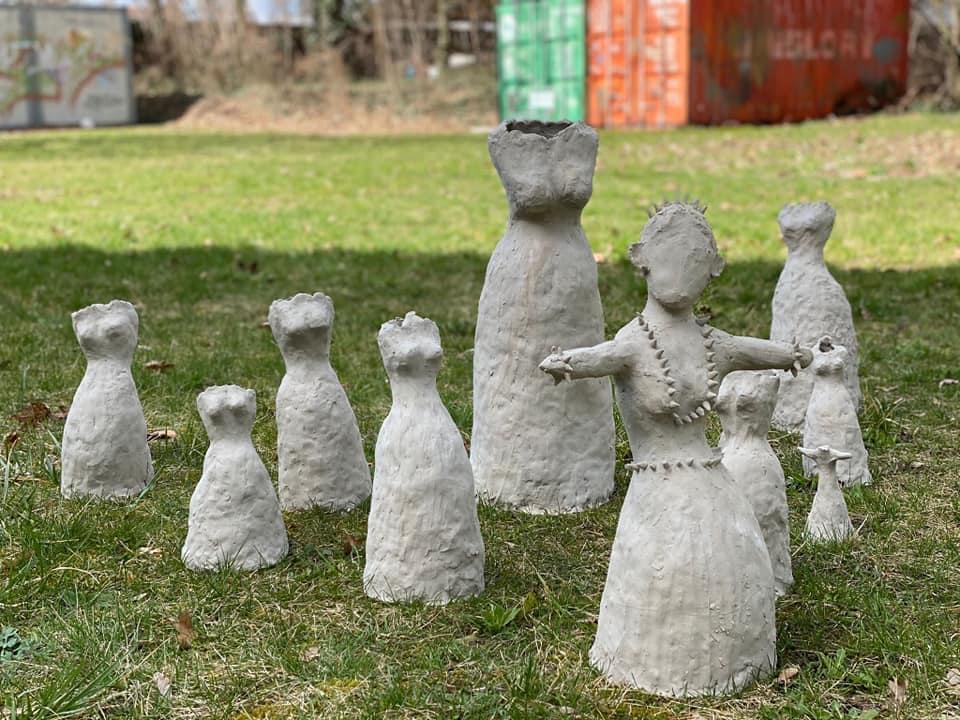In my artistic work, I strive to capture the complex and often overlooked lives of Bangladeshi women. Inspired by my own experiences and personal observations, I aim to highlight the daily challenges women face in this country.
The Life of Bangladeshi Women: Realities and Resilience
Bangladesh is a democratic country, but unfortunately, women’s safety is often compromised. Traveling alone is dangerous, sexual harassment is common, and too often, women cannot stay out late. Even women are deprived of their freedom of choice and action. And above all, sometimes we don’t even have the freedom to make our own decisions. We often hear, “You are a woman, you can’t do this, you can’t do that.”
Women Through My Art
At the heart of my artwork is the Portrait of a Faceless Woman, a powerful metaphor for how women are often reduced to stereotypical roles, without individuality or a voice. My headless sculptures, inspired by traditional Bengali Clay Dolls, symbolise a femininity controlled and devoid of decision-making power.

A central element of my artistic approach is the portrait of a faceless woman with a crown of thorns, drawn on the wood of a Mont d’Or cheese box with an ink pen. This unexpected material, discovered during my volunteering at the Red Cross food distribution, inspired me to create a piece that questions the roles assigned to women in Bangladeshi society. In Bangladesh, most women are housewives and spend a lot of time preparing meals for their families, often without recognition or respect.

My headless dolls reflect this reality, symbolising the social pressure to be the ideal woman, submissive and without personal will. To receive compliments as an ideal and kind woman, it’s better not to have your own thoughts and be controlled by someone else. But if you try to protest or make your own decisions, people say you’re a disobedient woman. There’s only one doll with a head, faceless and with a crown of thorns. If you want to make your own decisions or try to do something as you wish, you must suffer, accept being insulted by others, and take responsibility for protecting yourself.





For my ceramic sculptures, I was also inspired by my childhood, where playing with dolls was a source of joy. Clay was the first material I used for creation as a child. I grew up in a village and made dolls and kitchen utensils to play with. We were happy when someone said, “like a doll.” However, I realised that this term was not a compliment but rather a metaphor for women’s subjugation.

A Poignant Moment of Emotional Shock
Newspapers and television often talk about gang rapes and women killed by rapists. We filed a complaint with the police, but the rapist was never arrested or punished. The woman who is assaulted or raped is blamed for her clothing. It becomes normal for us.
The idea for my work was profoundly influenced by a tragic event on December 16, 2020, in Bangladesh: the rape and murder of a young woman. This day, celebrated as Victory Day in Bangladesh, reveals the cruel irony of the condition of women in our society. If even on this festive day, women are not safe, what meaning does our victory hold?

Hope for the Future
As an artist, my work is a manifesto against rape and sexual assaults on women. Through my creations, I aim to raise awareness and inspire positive change. I hope that my art can shed light on the struggles faced by women and ignite conversations that lead to action.
With a woman Prime Minister leading our nation, I dare to believe in a future where Bangladeshi women can live in the safety and freedom they deserve. My art is not just an expression but a call to society to acknowledge and address these issues, working together towards a world where every woman feels secure and empowered.


Leave a Reply